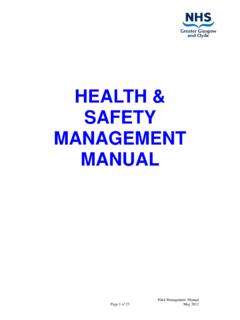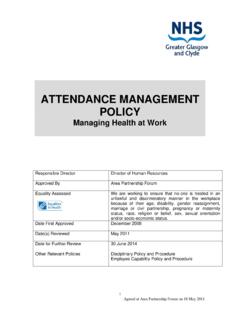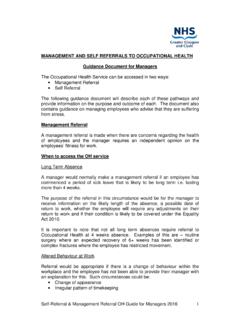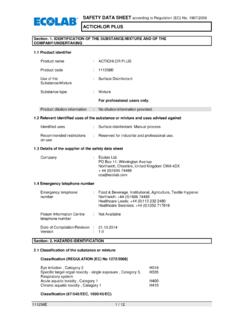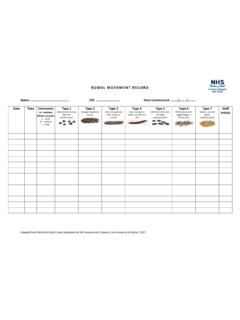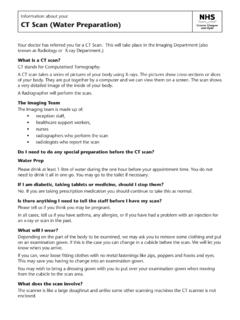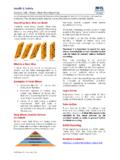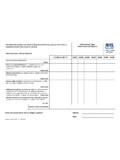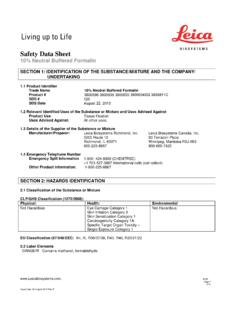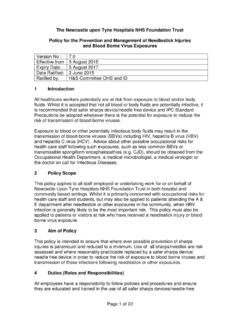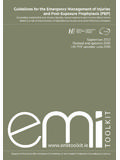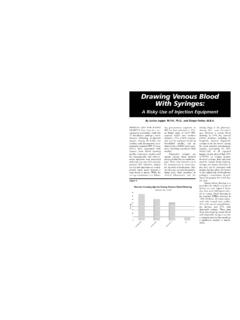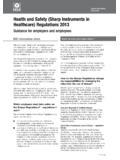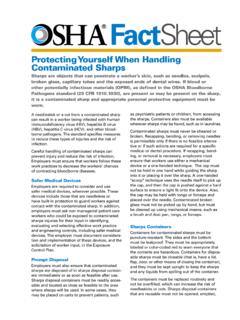Transcription of MANAGEMENT OF NEEDLESTICK INJURIES AND …
1 * The full guideline and supporting documentation can be accessed at MANAGEMENT OF NEEDLESTICK INJURIES AND EXPOSURES TO BLOOD AND HIGH-RISK BODY FLUIDS YES NO Initial Action Plan 1. IMMEDIATELY FOLLOWING exposure Apply First Aid Encourage local bleeding of accidental puncture wounds by gently squeezing. DO NOT SUCK THE AREA Wash the affected area with soap and warm water. DO NOT SCRUB THE AREA Treat mucosal surfaces such as mouth or conjunctiva by rinsing with warm water or saline. Water used for rinsing the mouth must not be swallowed. DO NOT USE BLEACH ON THE INJURY 2. ASSESS THE INJURY Establish whether a significant injury has occurred In order for an injury to be considered significant, both the type of injury incurred and the body fluid involved must be high-risk. See boxes 1 and 2 below for definitions of high-risk INJURIES and body fluids.
2 If the injury involves contact with HIV infected blood discuss with infections disease physician on call. 3. HAS THIS BEEN A SIGNIFICANT INJURY? Health Care Worker The risk of infection with a bloodborne virus is extremely small. Inform Occupational Health Department at earliest opportunity. Complete Datix form With your supervisor, reflect on the cause of the injury and take steps to ensure the future risk of such incidents is reduced. Member of the public Re-assure that the risk of infection with a bloodborne virus is extremely small, and that no further action is required. If further reassurance is needed, advise to contact GP who can arrange further support if required. Support can be accessed through the Sandyford Services. If the incident has occurred during the course of the patient s work, advise him/her to inform their Occupational Health Department (where applicable) at the earliest opportunity.
3 Health Care Worker Report injury to supervisor Inform Occupational Health Department immediately or, if out of hours, go to A&E as soon as possible, ideally within one hour of the incident occurring. Supervisors should refer to section 1 of the guideline MANAGEMENT of occupational exposures to bloodborne viruses* for guidance on roles and responsibilities. Member of the public Refer patient to the A&E as soon as possible, ideally within one hour of the incident occurring. Those treating the injured person should follow the guideline MANAGEMENT of occupational and non-occupational exposures to bloodborne viruses* Box 1: Injury type High-Risk Injury Low-Risk Injury Percutaneous exposure NEEDLESTICK / other sharps injury exposure on broken skin Mucous membrane exposure ( eye) Human Bite Splash on intact skin there is no known risk of BBV transmission from exposures to intact skin.
4 Box 2: Body fluid High-Risk Body Fluid Low-Risk Body Fluid (unless blood-stained) Blood Blood-stained low risk fluid Semen Vaginal Secretions CSF Pericardial fluid Peritoneal fluid Pleural fluid Saliva associated with dentistry Amniotic fluid Breast milk Synovial fluid Unfixed tissues or organs Urine Vomit Saliva Faeces Must be used in conjunction with the NHSGGC guideline: MANAGEMENT of occupational and non-occupational exposures to bloodborne viruses MANAGEMENT OF NEEDLESTICK INJURIES AND EXPOSURES TO BLOOD AND HIGH-RISK BODY FLUIDS Poster for use in Accident and Emergency The full guideline and supporting documentation can be accessed at following link through staff net StaffNet > Info Centre > Policies, Procedures and Guideline Documents > NHS GG&C Clinical Guideline Electronic Resource Directory HBV assessment and prophylaxis.
5 See section 2 of guideline for full details on managing Significant exposure Non-significant exposure HBV status of person exposed HBsAg positive source Unknown source HBsAg negative source Continued risk No further risk 1 dose HB vaccine pre-exposed Accelerated course of HB vaccine* HBIG x 1 Accelerated course of HB vaccine* Initiate course of HB vaccine Initiate course of HB vaccine No HBV prophylaxis. Reassure 2 doses HB vaccine pre- exposure (anti-HBs not known) One dose of HB vaccine followed by second dose one month later One dose of HB vaccine Finish course of HB vaccine Finish course of HB vaccine No HBV prophylaxis. Reassure Known responder to HB vaccine (anti-HBs > 10mIU/ml) Consider booster dose of HB vaccine Consider booster dose of HB vaccine Consider booster dose of HB vaccine Consider booster dose of HB vaccine No HBV prophylaxis.
6 Reassure Known non-responder to HB vaccine (anti-HBs < 10mIU/ml 2 4 months post-immunisation) HBIG x 1 Consider booster dose of HB vaccine A second dose of HBIG should be given at one month HBIG x 1 Consider booster dose of HB vaccine A second dose of HBIG should be given at one month No HBIG Consider booster dose of HB vaccine No HBIG Consider booster dose of HB vaccine No HBV prophylaxis. Reassure *An accelerated course of vaccine consists of doses spaced at zero, one and two months. A booster dose may be given at 12 months to those at continuing risk of exposure to HBV. Source: PHLS Hepatitis Subcommittee (1992). Box 1: Injury type High-Risk Injury Low-Risk Injury Percutaneous exposure NEEDLESTICK / other sharps injury exposure on broken skin Mucous membrane exposure ( eye) Human bites that break the skin Splash on intact skin there is no known risk of BBV transmission from exposures to intact skin.
7 Box 2: Body fluid High-Risk Body Fluid Low-Risk Body Fluid (unless blood-stained) Blood Blood-stained low risk fluid Semen Vaginal Secretions CSF Pericardial fluid Peritoneal fluid Pleural fluid Saliva associated with dentistry Amniotic fluid Breast milk Synovial fluid Unfixed tissues or organs Urine Vomit Saliva Faeces No significant injury: Reassure no further action required. If the injury involved contact with HIV positive blood discuss with Infection Disease physician on call. Advise health care workers to complete a Datix form and to inform their Occupational Health Department as soon as possible. If there is potential for repeated exposure to Bloodborne Virus (BBV), check hepatitis B vaccination history. If unvaccinated or incomplete, advise to attend their Occupational Health Department for vaccination.
8 Members of the public requiring further reassurance should be advised to contact their GP who can arrange further support if required. Significant injury: If source patient is known, liaise with clinician undertaking the source patient risk assessment to establish: the risk status of the source, whether blood has been taken for BBV testing, and when the blood results will be available. Assess the need for HIV PEP, HBV prophylaxis and follow-up BBV testing: see guidance below. Take storage blood. Request form should state type of injury and blood for storage . See section 3 of guideline for lab information. Arrange all appropriate follow-up: Appointment with Infectious Disease physicians if HIV PEP started. Occupational Health (Health Care Worker) or GP (others) if further hepatitis B vaccination and follow up BBV testing required.
9 Referral to counselling services if required. Advise health care workers to complete an Datix form and to inform their Occupational Health Dept. as soon as possible. Instruct the injured Health Care Worker (HCW) to inform occupational health regardless of the outcome of the risk assessment. Ensure first aid has been undertaken See section 1 of the guideline Assess the injury Establish whether a significant injury has occurred. In order for an injury to be considered significant, both the type of injury and the body fluid involved must be high-risk. See boxes 1 and 2 below for definitions of high-risk INJURIES and body fluids. Note: For advice on how to manage human bites, see section 1 of the guideline Source patient risk assessment The nurse in charge of the source patient is responsible for the initial risk assessment and MANAGEMENT of the source patient but can delegate BBV testing to a junior doctor or other as appropriate.
10 The source patient BBV risk assessment and, if consent given, BBV testing, should be undertaken immediately. Undertake BBV testing on all consenting source patients irrespective of the result of the risk assessment. Follow the NHSGGC MANAGEMENT of Occupational and Non-occupational Exposures to Bloodborne Viruses including ~ NEEDLESTICK INJURIES & Sexual Exposures Guidance and use the source patient risk assessment letter and form. See appendices 1 & 2 HCV Assessment There is no vaccine or post exposure prophylaxis available for HCV. There are effective treatments, however, and it is important that those exposed receive appropriate follow-up so that treatment can be initiated should they become infected. HIV assessment and post exposure prophylaxis (PEP) Has a significant injury occurred? (see above for definition of significant injury) HIV PEP NOT INDICATEDR eassure NNOO Has source patient been identified?
